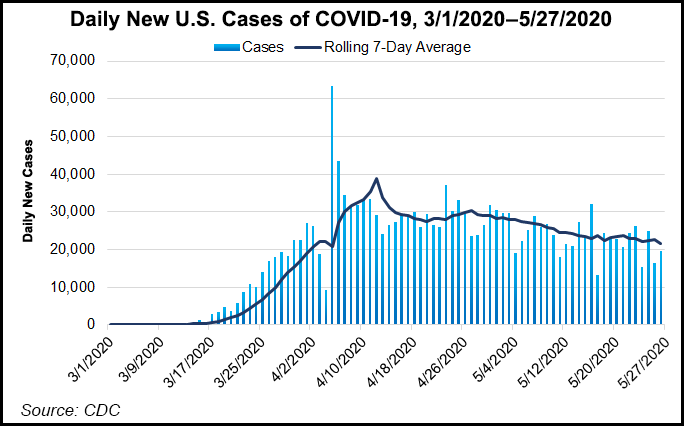Shale Daily | Coronavirus | E&P | Eagle Ford Shale | Markets | NGI All News Access | NGI The Weekly Gas Market Report
U.S. E&Ps Step up Hedging as Covid-19 Disrupts Pricing, Demand
The dislocations from Covid-19 to global energy demand have led to shut-ins and production cutbacks in the United States, and operators are responding by increasing oil and natural gas hedging into 2021.

Using information from exploration and production (E&P) operators covered by Goldman Sachs, analysts estimated that through March, 47% of 2020 natural gas production was hedged, along with 66% of oil.
“Our update on covered producer hedging on the back of 1Q2020 results suggests an increase in 2020 oil hedging to recent highs, while 2021 liquids/natural gas hedging is above historical averages,” analysts said. “Relative to last quarter, we saw an 18% increase in 2020 oil production hedged,” with 60% of the increase resulting from increased hedges and 40% from lower production because of shut-ins and reduced activity.
For 2020, Goldman’s Henry Hub gas price base case is $2.14/MMBtu, and the base case for West Texas Intermediate (WTI) oil is $31.77/bbl.
“Current hedged 2020 oil prices of $44.19/bbl (assuming $31.77/bbl WTI for collars) are well above strip prices of $33.57/bbl,” said the Goldman team.
“For natural gas, 2020 hedging is at 47% of 2020 production (versus 41% last quarter); current hedged 2020 gas prices of $2.66/MMBtu (assuming $2.14/MMBtu Henry Hub for collars) are well above strip prices of $2.04/MMBtu. Producers are hedged at 10%/28% of 2021 liquids/natural gas production, slightly above the five-year seasonal average of 8% for liquids and well above the 19% average for gas.”
Whether Lower 48 E&Ps hedge or not varies from company to company. Eagle Ford Shale independent Penn Virginia Corp. is an advocate, CFO Rusty Kelley explained during the 1Q2020 conference call.
As Covid-19 began usurping energy demand, Penn Virginia in March cut capital expenditures (capex) by 30%. The cuts, along with the hedge portfolio and free cash flow profile, provide a cushion “to operate comfortably, including the ability to restart our capital program when the commodity price environment warrants it,” he said.
The proactive risk management strategy is designed to protect cash flow while retaining options to capture the upside on pricing.
“We took the opportunity before the latest dramatic downturn in oil prices to create a substantial risk management portfolio of put hedges and during the second and third quarters of 2020 over and above the originally anticipated volumes,” Kelley said.
More than 32,000 bbl of oil was hedged for 2Q2020 as of early May.
“We produced just over 20,000 b/d in the first quarter,” Kelley said, with the hedge position representing “more than 150% of what we produced in the first quarter…Given the anticipated shut-ins and national production declines due to capex reductions, we anticipate that percentage to climb even further during the second quarter.”
Penn Virginia’s hedge book in early May was “in the money with a mark-to-market value of approximately $138 million,” said Kelley. “To put it simply, we make more money in the near term when oil prices go lower, so we believe we’re well positioned for the current low oil price environment” and stand to “retain upside exposure in the event of an oil price recovery.”
© 2024 Natural Gas Intelligence. All rights reserved.
ISSN © 2577-9877 | ISSN © 1532-1266 | ISSN © 2158-8023 |
